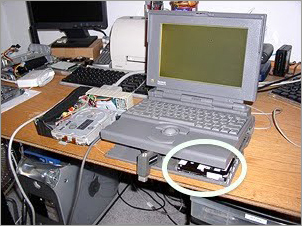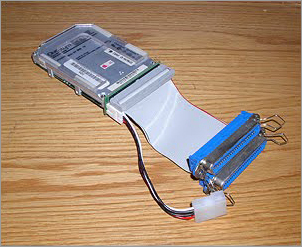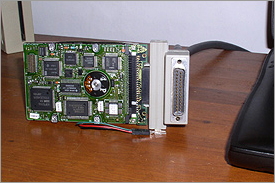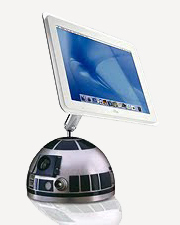Reading PowerBook 2.5″ SCSI Hard Drives
Back in the 68k era Apple used small form factor 2.5″ SCSI hard drives in the PowerBook 100, 500 and Duo lines of notebooks. Use of the SCSI format provided compatibility with desktop Macs of the same era and permitted the use of external SCSI Disk Mode – the precursor to today’s Target Disk Mode.
 The 2.5″ SCSI form factor was not widely used throughout the industry, however. Most vendors (and soon Apple themselves) utilized ATA (IDE) drives. ATA remained the industry standard until SATA took over this past decade.
The 2.5″ SCSI form factor was not widely used throughout the industry, however. Most vendors (and soon Apple themselves) utilized ATA (IDE) drives. ATA remained the industry standard until SATA took over this past decade.
Occasionally somebody with an old SCSI-based PowerBook will contact me about transferring files from their old system. If their PowerBook doesn’t boot, or the drive was previously removed from the computer, it becomes necessary to access the disk directly.
The scarcity of the 2.5″ form factor means that there aren’t many ways to read old PowerBook hard drives without having to install them in another PowerBook. A few external SCSI enclosures were made for this size but they can be hard to find today. Installation is not super difficult in the old models, but it isn’t trivial either. A sacrificial model is needed for the endeavor (I use a PowerBook 170, as shown). If the drive doesn’t boot your PowerBook you need to startup from a System Folder on an external SCSI drive in order to access the internal disk.
 Another recent file transfer request got me searching for an external enclosure or adapter of some kind. After a fair amount of Googling I finally found a
Another recent file transfer request got me searching for an external enclosure or adapter of some kind. After a fair amount of Googling I finally found a 40 54 pin (2.5″) to 50 pin (3.5″) SCSI adapter. This allows access to the smaller drives using a standard 50 pin ribbon cable and a 4 pin 5V/12V power cable.
I used the cabling from an external case to make an even more versatile adapter. The piece of ribbon cable has a 50 pin internal connector sandwiched between two external Centronics-style SCSI connectors. With this new rig and power provided by my external drive sled, I’m now able to connect old 2.5″ disks directly to my trusty Wallstreet’s SCSI port and bridge the years without having to put my 170 into traction each time.
A much needed little adapter!
Update 2012:
 After posting this update I acquired an external disk enclosure for 2.5″ SCSI drives. Once you remove the covers from these enclosures the remaining circuitry forms an adapter (or “sled” if the bottom panel is still attached) to use to connect bare internal drives to external SCSI connectors – in this case a standard DB25 SCSI cable. This is smaller and easier to deal with than the hybrid adapter described above, and has become my main PowerBook data transfer drive tool. 2.5″ external SCSI disk enclosures are occasionally available on eBay.
After posting this update I acquired an external disk enclosure for 2.5″ SCSI drives. Once you remove the covers from these enclosures the remaining circuitry forms an adapter (or “sled” if the bottom panel is still attached) to use to connect bare internal drives to external SCSI connectors – in this case a standard DB25 SCSI cable. This is smaller and easier to deal with than the hybrid adapter described above, and has become my main PowerBook data transfer drive tool. 2.5″ external SCSI disk enclosures are occasionally available on eBay.


ORIGINAL BLOGSPOT COMMENTS:
Thomas Carlson said…
Adam, would something like this be useful?
http://cgi.ebay.com/New-Macintosh-Slim-2-5-SCSI-Hard-Drive-Storage-Case-/360281595711?cmd=ViewItem&pt=LH_DefaultDomain_0&hash=item53e274df3f
Cheers, Tom
July 20, 2010 at 9:38 AM
Adam Rosen said…
Yeah, that’s the kind of case which is required. I don’t think there were any listed on eBay when I was looking a few weeks back.
July 20, 2010 at 11:47 PM
Yuhong Bao said…
“If the drive doesn’t boot your PowerBook you need to startup from a System Folder on an external SCSI drive in order to access the internal disk.”
Don’t forget SCSI disk mode, which can be used by the 100 and the 160/180 and later.
July 21, 2010 at 1:42 AM
Adam Rosen said…
Yuhong, SCSI Disk Mode may work in some situations but you still need to install the drive in a PowerBook, then boot the PowerBook to set the SCSI target address. My goal here was to avoid having to open up an old PowerBook each time and use an external adapter or enclosure instead.
July 21, 2010 at 8:30 AM
niclet said…
Hi Adam, I’m nearly in the same situation with two clients both with the same PowerBook 145. I have to recover data from those Hard drive (which are Conner 2045 SCSI drive) and I ordered an old 2.5″ slim SCSI enclosure from ebay (they still have a couple left, see the link below *). But it appears that the enclosure’s internal connector is a 50-PIN (according to the seller) and, as you know, the drive is 40-PIN. I looked for a similar 40 to 50 PIN adaptor as yours on the photos, but didn’t find any. Can you give me a cue on this: where can I buy one?
Thanks
* There’s a lot of these “New 2.5″ SCSI Hard Drive External Case” here:
http://stores.ebay.com/MC-PRICE-BREAKERS-SCSI-STORE-n-MORE_Vintage-Apple-Mac_W0QQ_fsubZ862113018QQ_sidZ89318QQ_trksidZp4634Q2ec0Q2em322
November 2, 2010 at 2:00 AM
Adam Rosen said…
Niclet, I found the adapter here: http://www.cablesonline.com/25lapscsihar.html
November 2, 2010 at 8:30 AM
niclet said…
Thank you so much Adam. I don’t understand why I didn’t find it?!
But it says: «This adapter converts a 54 pin laptop hard drive to use like a regular 50 pin SCSI hard drive» Will it still be fine ?
November 2, 2010 at 11:11 AM
Adam Rosen said…
I believe that only 40 pins are active in the connector, hence the confusion. If I’m wrong, Yuhong will probably correct me! :) But this is the correct adapter for the old PB SCSI drives.
November 2, 2010 at 11:37 AM
John Gee said…
Dear Adam – This is a very helpful page, but I’m not very computer literate and need a little more clarification. I have a Powerbook 145 that I dropped and it’s not working. Will the SCSI adaptor that you link to connect directly to the hard drive and plug into another computer (I have a white mac, a slightly older mac laptop, and a Dell PC in my case), or do I need anything else? I’m looking at the small plug at one end of this device and it doesn’t seem to be compatible with any hole I can see on any of these.
Thanks.
November 29, 2010 at 4:46 PM
Adam Rosen said…
John, the adapter above will allow you to connect your PowerBook drive to a standard internal 50 pin SCSI cable, as used inside a computer or drive enclosure. It will not plug into the back of the computer, and you’ll need to remove the drive from the PB first.
November 29, 2010 at 5:26 PM
Anonymous said…
Many thanx for the help!
March 1, 2011 at 4:00 AM
Anonymous said…
If I connect my Powerbook 145B 2.5 to my PC (using the cases/adapters suggested here), will my PC be able to read the HD? The operating system on my PC is XP. Thank you.
August 8, 2011 at 11:35 AM
Adam Rosen said…
No, the PowerBook drive is formatted with the Mac HFS filesystem which is not a native Windows drive format.
August 8, 2011 at 3:11 PM
Anonymous said…
What are you using to attach the adapter to your G3? Is it just a regular SCSI peripheral interface cable going from the hard drive/Centronics connector to the back of the computer? Also, is there anything more I need to know about the power requirements of the hard drive since I don’t have a drive sled, but do have access to a variable power supply.
On the other hand would a “new 2.5″ external SCSI HD case” simply plug (with standard interface cable) into the external scsi port of a G3? Thanks!
October 22, 2011 at 10:47 PM
Adam Rosen said…
If you make an adapter like I did above then yes a standard SCSI D25-to-Centronics 50 pin cable is all that’s needed. The hard drive power cable supplies 5V and 12V DC.
Or yes, you can pickup a 2.5″ external SCSI HD case and use that. I didn’t have one handy when I made the adapter.
October 23, 2011 at 8:53 AM
I just cracked open my PowerBook Duo 230 to remove the hard drive to recover some data that I never transferred from it. I have followed the links provided and have not found the products that are required.
What I want to do is convert from the scsi to usb is this possible? I want to be able to do is simply mount the drive much like an external is this feasible?
Hi Hector – you will need to convert the 2.5″ SCSI drive to a standard 50-pin Centronics or 25-pin D-Sub connector before using a USB-to-SCSI adapter. You may be able to purchase a 2.5″ external SCSI enclosure and put the drive in that, to use with a USB adapter. I also offer this service through the Mac Museum, feel free to contact me if you’d like some assistance.
This article has been very helpful, I have an old 40-pin SCSI from a PowerBook that I want to interface with my Mac IIci. Following the link in your article I found that the 54-pin to 50 pin SCSI is available. If that is the correct adapter then all I need are cables for a DB-25 SCSI plug.
Hi Derek, if you have a IIci another option is to connect the PowerBook drive with adapter internally using the SCSI ribbon cable. You can pickup a longer cable with more connectors, just make sure the SCSI ID numbers are unique for each drive.
I have assembled the adapter to connect my old PowerBook drive, although the connector is not quite deep enough to fully engage the pins on the drive. Any suggestions on a fix?
That’s a tough one, does it work if you press and hold them together? Can you wedge things temporarily long enough to copy the drive? Ultimately I can do the data transfer, if you can’t get things working.
I can’t tell if the pins are engaged though I can hold the plug and drive together. I will try to power up the drive this weekend and then try to access it.
Another question, with this adapter how do I manage the SCSI ID?
There should be small pins and jumpers on the drive itself to set the ID.
There are a group of pins to one side of the connector, otherwise I don’t see anything else on the drive.
My need for the drive is temporary, provide an intermediary to copy files between the IIci and my PC while finish translating old documents to PDF.
Okay, I was able to start the drive and install the microtech software. The USB interface was detected by windows XP though not identified. I installed the microtech software without errors. On reboot after install, the USB interface was not detected. I checked the hardware status and saw that the USB driver was not loaded.
Can you offer any suggestions on troubleshooting?
Hi Derek, this has moved beyond what I can address in the blog comments. I would be happy to setup time for a Support Call if you’d like, please contact me directly to arrange for consulting services.
Thank you. I will also contact Microtech and see if they have ideas.
While testing out my adapter, I noticed a LED on the SCSI adapter plug that connects to the drive. Should this light up while the drive is running?
Also, have you seen a powered SCSI terminator before, looks like the Microtech USB adapter needs a power source.
I found two problems with my interface, I needed to add termination to the drive and the drive is not supplying power to the Microtech adapter. I have switched to a cardbus adapter and added a thru-terminator to the drive.
I am trying to connect several SCSI drives to the my Windows XP machine via an Adaptec USBExpress adapter. The drives are accessible in system 7 though I cannot get the adapter drivers to load. I wondered if you had encountered similar problems.
I have a Mac IIci with an ailing internal drive. I may be able to fix it. Although I am considering using the SCSI powerbook drive as a replacement. I have the adapter board for it, although how do I terminate it and set the SCSI id?
I have a PowerBook SCSI drive with the adapter, can this be installed and formatted to work on a MacIIci running System 7?
Yes it should work, but I wouldn’t recommend it for ongoing operations. Just data transfer or interim services if required.
I also have a Mac IIci and a conner CP-2045 Powerbook drive and have been trying to get it up and running at least temporarily. I have an inquiry in with cables online WRT their laptop adapter.
Adam, you have this setup running so I hope you can answer a couple of questions, first, the drive implies no jumpers are necessary for SCSI ID=0 using the adapter as an internal drive, so this is OK? Also, how does the adapter handle the termination issue?
Last, why would you not recommend this setup for long term usage (per above)?
Tks D.
Hi Dave – SCSI ID 0 is the standard address for internal drives, on those mini 2.5″ disks you may not need to set any jumpers. They will default to ID 0. Just make sure no other devices on the SCSI bus are set to that same address.
Inside the PowerBook you don’t need a terminator, the internal SCSI bus is designed for a single device only. If you’re using the drive in another Mac, unless your adapter provides termination you will need to use a multi-device SCSI ribbon cable with the drive as a middle device and a separate terminator (active or passive) on the end.
The reason I recommend this setup for interim use only is that these drives are approaching 30 years old. They aren’t hardware you want to rely upon for regular use, rather just to retrieve data if needed. To use a vintage Mac on a regular basis I recommend installing a SCSI-to-CF (Compact Flash) or SCSI-to-SD adapter. They’re faster and more reliable.
Thanks Adam
I’m leaning toward the SD approach for a long term solution but since I have the 2.5″ HD I’d also like to keep that option on the table or at least understand the issues.
I have a dual centronics + 50 pin cable exactly like the one in the photo that I can use with the 2.5 to 3.5 adapter card, did you terminate your setup with something like the in-line centronics pass through terminations?
I have also made an adapter cable matching the pinouts for 40 & 50 pin SCSI & the Apple PB cable. The only questions I have is handling the non-power grounds. I connected the necessary 2.5″ grounds (identified from the Apple cable) to convenient grounds in the even number pins of the 50 pin side.
So far I haven’t gotten the Mac to find the HD; internally, without & with termination, and externally with & without termination. Termination was using a centonics connector + terminator in the ribbon between the HD & 50 pin connector.
Any suggestions?
Tks. D
It doesn’t matter whether you use an inline terminator between the drive and ribbon cable, or a terminator on the Centronics connection, same result. SCSI can be tricky, the term SCSI voodoo was quite common back in the day. A powered terminator might help.
Hi – I found my old Powerbook Duo 230 (I got rid of the Dock years ago). It works perfectly. In fact, my little niece and nephew had turned it on and were playing games on it. I had a bunch of old word docs saved and I deleted them, but realistically if I want to give this away/sell it/do anything with it, do I need to acquire an external drive and the operating system floppy to reinitialize the hard drive (for safety/security reasons)?
Thanks!
Hi Dina, as long as you have deleted any personal files there really isn’t anything further you need to do to the system. Give it to someone who will enjoy the machine and give it a good home.
i have a powerbook duo 270c which i have owned for over 15 years.
it runs on OS 7.6
it has been working well and i usually boot it up a few times a year.
However recently it wont boot up. When i connect it to the ac, it tries to power up without me pressing the power button.
it gets to the MAC OS logo on start up and then switches off. This happens even if i do use the power button
Not sure if it is a hard drive failure?
I do not have OS7 on floppy disk to try to boot up this way. I do have OS7.6 on CD but I did not have a cd player i can use with this machine.
any suggestions?
Hi Simon, you can purchase boot floppy disks for old Macs at RescueMyClassicMac, which can help you in troubleshooting: http://rescuemyclassicmac.com
thanks Adam. will give it a try
Looking for a Mac classic compatible hard drive; eBay has a few. Are there other sources?
Hi Adam. I have an old PowerBook Duo 230 and a PowerBook 1400cs. The HDDs still work in both of them, and I wanted to take them out and plug them into my Linux box so I can use the dd command on them to make an image of their contents.
I wanted to plug the drives into the Linux computer via USB. What I am wondering is, can you give me a list of the things I need to buy to do this? All of the links I’ve seen here are dead, and I don’t know if I need that one CablesOnline adapter in my case.
Thanks, and great article!
Hi Joey, glad you found the article useful. The Duo 230 uses a SCSI drive, while the 1400cs uses an ATA drive. As far as what adapters you’ll need to connect these to a Linux system via USB, unfortunately I’m not the right person to answer that question. However if you can’t find a way to access the contents, this is a service I provide here at the Mac Museum.
Oh, I was unaware that the 1400cs used an ATA drive. That’s good, I already have an ATA to USB adapter. That should work fine.
Regarding the SCSI drive, I apologize if I may be repeating the question, but what adapter do I need to convert that SCSI connector to a USB/parallel/serial/etc. connection? Linux is optional, by the way. As long as I can connect it to a modern ( >2003) computer I am set. I can do the same cloning process in Linux, Windows, or macOS.
There is no single adapter which allows you to connect those small format SCSI drives via USB or any other serial protocol (SCSI means Small Computer Serial Interface). There were a number of USB-SCSI adapters made which connected to various flavors of SCSI-2 and SCSI-3 ports, one of those combined with the 54-to-50 pin adapter mentioned in this post – and some creative cabling – might work. But probably not easily, if at all.
That’s the most I can offer.
Ok, thanks for the info.
Hello
Can you ask for Scheme 2.5 “Laptop SCSI Hard Drive Adapter
Item # MK-007 because they do not send an adapter to Poland.
Thank you